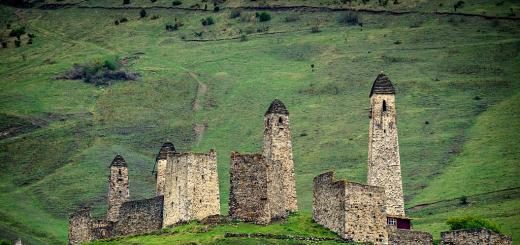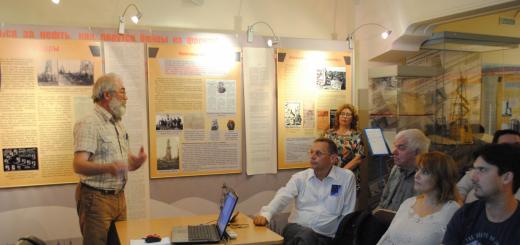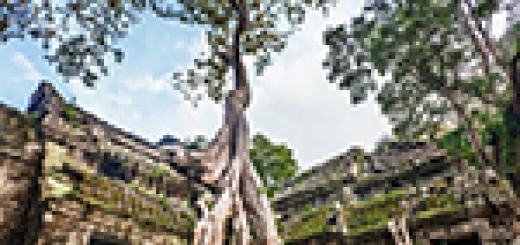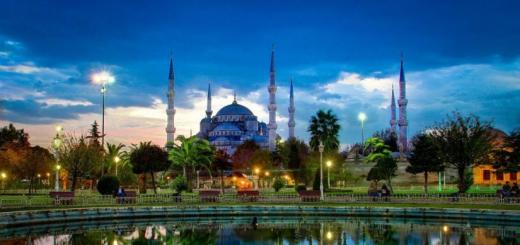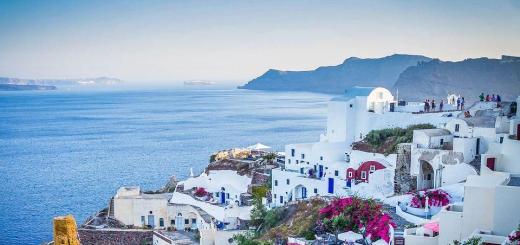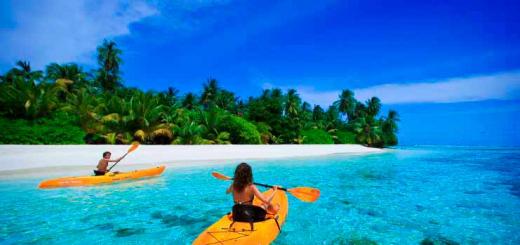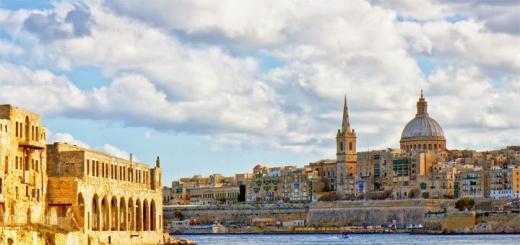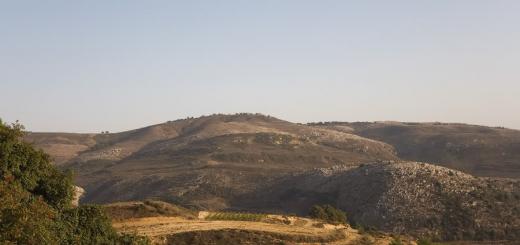The Volga River is a mighty water stream that carries its waters across the European territory of Russia and flows into the Caspian Sea. The total length from source to mouth is 3692 km. It is customary not to take into account individual sections of the reservoirs. Therefore, officially the length of the Volga is 3530 km... It is considered the longest in Europe. And the area of the water basin is 1 million 380 thousand square meters. km. This is a third of the European part of Russia.
The source of the Volga
The river begins its journey at the Valdai Upland. This is the Ostashkovsky district of the Tver region. On the outskirts of the Volgoverkhovye village, several springs gush out of the ground. One of them is considered the source of the great river. The spring is surrounded by a chapel, which can be reached by a bridge. All springs flow into a small body of water. A stream flows out of it, reaching a width of no more than 1 meter and a depth of 25-30 cm. The height above sea level in this place is 228 meters.
The stream is 3.2 km long. It flows into Lake Malye Verhity. It flows out of it and flows into the next lake, Bolshie Verhity. Here the brook widens and turns into a rivulet that flows into Lake Sterzh. It is 12 km long and 1.5 km wide. The average depth is 5 meters, and the maximum depth is up to 8 meters. The total area of the lake is 18 sq. km. The lake is part of the Upper Volga reservoir, which stretches for 85 km. After the reservoir, the Upper Volga begins.
The great Russian river Volga
Waterway of the great Russian river
The river is conventionally divided into three large sections. These are the Upper, Middle and Lower Volga. The first large city on the way of the water flow is Rzhev. From the source to it 200 km. The next large settlement is the ancient Russian city of Tver with a population of over 400 thousand people. Here is the Ivankovskoe reservoir, the length of which is 120 km. Next is the Uglich reservoir with a length of 146 km. The Rybinsk Reservoir is located north of the city of Rybinsk. This is the northernmost point of the great river. Further, it no longer flows to the northeast, but turns to the southeast.
A stream of water once carried its waters here along a narrow valley. It crossed a series of highlands and lowlands. Now these places have turned into the Gorky reservoir. On its banks are the cities of Rybinsk, Yaroslavl, Kostroma, Kineshma. Above Nizhny Novgorod is the regional administrative center Gorodets. Here the Nizhny Novgorod hydroelectric power station was built, forming the Gorky reservoir, stretching for 427 km.
The Middle Volga begins after reunification with the Oka. This is the largest right tributary. Its length is 1499 km. It flows into the great Russian river in Nizhny Novgorod. This is one of the largest cities in Russia.

Volga on the map
Having taken in the waters of the Oka, the Volga river becomes wider and rushes to the east. It flows along the northern part of the Volga Upland. Near Cheboksary, the Cheboksary hydroelectric power station blocks its road and forms the Cheboksary reservoir. Its length is 341 km, width is 16 km. After that, the course of the river shifts to the southeast, and turns to the south near the city of Kazan.
The Volga becomes a truly powerful river after the Kama flows into it. This is the largest left tributary. Its length is 1805 km. Kama surpasses the Volga in all respects. But for some reason it does not flow into the Caspian Sea. This is due to the historically established names and traditions.
After reunification with the Kama, the lower course of the great Russian river begins. It is moving steadily south towards the Caspian Sea. On its banks are such cities as Ulyanovsk, Togliatti, Samara, Saratov, Volgograd. Near Togliatti and Samara, the river forms a bend (Samarskaya Luka), directed to the east. At this point, the water stream goes around the Togliatti Mountains. Upstream is the largest Kuibyshev reservoir on the river... By its area, it is considered the third largest in the world. Its length reaches 500 km and its width is 40 km.

River pier in Saratov
Downstream of Samara is the Saratov Reservoir, which is 341 km long. It is formed by a dam built near the town of Balakovo.
From Samara to Volgograd, the river flows to the southwest. Above Volgograd, the left arm is separated from the main water flow. It is called Akhtuba. The arm of the arm is 537 km. The Volzhskaya hydroelectric power station was built between Volgograd and the beginning of Akhtuba. It forms the Volgograd reservoir. Its length is 540 km, and its width reaches 17 km.
Volga delta
The delta of the great Russian river begins in the Volgograd region. Its length is about 160 km, its width reaches 40 km.... It is included in the delta of almost 500 canals and small rivers. It is the largest estuary in Europe. The Bakhtemir arm forms the navigable Volga-Caspian canal. The Kigach River, which is one of the branches, flows through the territory of Kazakhstan. These places contain unique flora and fauna. Here you can find pelicans, flamingos, as well as a plant such as lotus.

Such ships sail along the Volga
Shipping
The Volga River underwent significant transformations during the Soviet era. Many dams were built on it, taking into account shipping. Therefore, ships easily get from the Caspian Sea to the northern regions of the country.
Communication with the Black Sea and the Don is carried out through the Volga-Don Canal. With the northern lakes (Ladoga, Onega), St. Petersburg and the Baltic Sea, communication is carried out through the Volga-Baltic waterway. The great river is connected with Moscow by the channel named after Moscow.
The river is considered navigable from the city of Rzhev to the delta... A wide variety of industrial goods are transported along it. These are oil, coal, timber, food. During the 3 winter months, the water stream freezes over most of its path.
The Volga has a very rich history. Many important political events are inextricably linked with it. The economic importance of the water flow is also disproportionate. It is the most important artery that unites many regions into a single whole. The largest industrial and administrative centers are located on its banks. There are as many as four millionaire cities alone. These are Kazan, Volgograd, Samara and Nizhny Novgorod. Therefore, the mighty waters are rightfully called the great Russian river.
The Volga River is one of the greatest rivers in Russia and the longest and most abundant in Europe.
The length of the river is 3530 km, and at the same time, among the Russian rivers it is along.
Many events in the history of our country are associated with the Volga.
Geographic characteristics
The Volga is the central waterway of the country and flows along its European part through the East European (Russian) Plain. It is the largest river in the world that flows into an inland body of water. The area of the delta formed by the Volga is 19,000 square meters. km.
The great river takes its beginning from a small source of groundwater, located near the village of Volgoverkhovye and located at an altitude of 229 meters above sea level.
A small brook, receiving about 150,000 tributaries, among which there are about 200 small and large rivers, is gaining power and strength and turns into a mighty river that flows into the Caspian Sea.
The fall of the river along its entire length does not exceed 250 meters, and the basin area is 1360 thousand square meters. km. The Volga River basin stretches from the Urals on the eastern side to the Central Russian and Valdai Uplands in the west.
Hydrological regime
 The reservoir receives the main food from the melted spring waters.
The reservoir receives the main food from the melted spring waters.
Summer rains and groundwater, which feed the river in winter, play a slightly smaller role in its feeding.
In connection with these features, three periods are distinguished in the annual level of the river: long and high spring floods, stable summer low-water periods and low winter low-water periods. The flood period averages 72 days.
The maximum rise in water is usually observed in the first half of May, that is, approximately two weeks after the spring ice drift. From June to October-November, a summer low-water period is established, which coincides with the navigation period. It is at this time, when the river is free of ice, that navigation is possible. The Volga is one of the most important waterways in Russia.
Three sections of the river are conventionally distinguished:
- Upper Volga - from the source to Nizhny Novgorod (the mouth of the Oka).
- Middle Volga - from the mouth of the Oka to the mouth of the Kama.
- Lower Volga - from the mouth of the Kama to the Caspian Sea.
The Upper Volga extends mainly in the forest zone, flowing through large forests, while the route of the middle part of the river runs through the forest-steppe belt. The Lower Volga keeps its way in the steppe and semi-desert zones. The bottom of the Volga in different places can be sandy or silty, often there are silty-sandy areas. On the rifts, the soil is mostly pebble or gristly.
The maximum temperature of the river at the peak of summer reaches 20-25 degrees, in winter the river is covered with ice along its entire length: the upper and middle parts freeze until the end of November, the lower Volga - at the beginning of December. The appearance of reservoirs on the river led to a change in the thermal regime of the Volga. So, on the upper dams the period of ice captivity has increased, and at the lower dams it has decreased.
The nature of the Volga basin
 The Volga floodplain is complex and unequal. Its flora and fauna are most diverse in the area of the lower Volga, at the mouth of a reservoir, a unique natural complex of which is represented by 1500 species of insects, almost 50 species of fish, more than 900 species of plants, 3 species of amphibians, 33 - mammals, 250 - birds, 10 - reptiles.
The Volga floodplain is complex and unequal. Its flora and fauna are most diverse in the area of the lower Volga, at the mouth of a reservoir, a unique natural complex of which is represented by 1500 species of insects, almost 50 species of fish, more than 900 species of plants, 3 species of amphibians, 33 - mammals, 250 - birds, 10 - reptiles.
That is why the unique Astrakhan Biosphere Reserve was founded in the Volga delta, many rare animals, birds and fish of which are listed in the Red Book of the Russian Federation, as well as in the International Red Book.
Here you can see the white-tailed eagle, pelican, great egret, mute swan. Wild boars can be seen in the thickets along the banks of the Volga, seals are preserved on the seashore, and saigas are preserved on the steppe plains. One of the world's largest bird migration corridors runs through the Volga delta.
The Volga is one of the richest rivers in Russia, the waters of which have about 80 species of fish: sturgeon, pike, burbot, beluga, catfish, carp, ruff, bream, white fish and many others. Commercial fishing of many species is widely developed. Since ancient times, the Volga River was considered one of the best places for fishing.Due to its unique natural resources and geographical location, the river has long attracted people to its banks, where they built their settlements, which eventually turned into cities and towns with surrounding villages. The development of shipping contributed to the emergence of trading cities - ports, located along the entire course of the river. The largest of them are Volgograd, Samara, Kazan, Nizhny Novgorod.
 Since the 1930s, the Volga has been used as a source of hydropower. Nowadays, about 50% of the agricultural production of the Russian Federation is concentrated in the river basin. The Volga provides more than 20% of the total fishing industry in the country. There are 9 reservoirs and hydroelectric power plants built here. Therefore, it rises quite sharply.
Since the 1930s, the Volga has been used as a source of hydropower. Nowadays, about 50% of the agricultural production of the Russian Federation is concentrated in the river basin. The Volga provides more than 20% of the total fishing industry in the country. There are 9 reservoirs and hydroelectric power plants built here. Therefore, it rises quite sharply.
According to experts, the load on the river's water resources is eight times higher than the national average, and 65 of the 100 most polluted cities in Russia are located in the Volga basin.
Environmentalists are sounding the alarm: the Volga waters are seriously polluted. Monitoring data confirm that the quality of water in the Volga and its tributaries and reservoirs does not meet the Russian quality standard for a number of parameters. The most serious ones arise in connection with:
- the presence of a large number of dams;
- the work of large industrial enterprises and complexes;
- the abundance of polluted wastewater from big cities;
- intensive navigation.
Impact of waste water
 The main cause of river pollution is the discharge of untreated and insufficiently treated wastewater. The reason for this lies in the physical and technological wear and tear and, as a consequence, the inefficiency of the treatment facilities of industrial and municipal enterprises.
The main cause of river pollution is the discharge of untreated and insufficiently treated wastewater. The reason for this lies in the physical and technological wear and tear and, as a consequence, the inefficiency of the treatment facilities of industrial and municipal enterprises.
The pollution of the Volga water directly affects the condition of its inhabitants. Data from various studies have shown the presence of mutations and congenital malformations in some fish populations.
Blooming water
Also, the appearance in the river of blue-green algae, capable of actively absorbing oxygen during decomposition and releasing up to 300 types of toxic substances into the environment, most of which have not yet been studied, was noted. About 20-30% of the water surface of the Kuibyshev reservoir is annually covered in summer by a film of these algae. After dying off, algae that have fallen to the bottom release phosphorus and nitrogen, thereby creating an ideal environment for self-reproduction, as a result of which secondary pollution of the reservoir occurs.
The presence of dams
 According to experts, the situation is complicated by the fact that after the construction of the dams, the river lost its ability to cleanse itself.
According to experts, the situation is complicated by the fact that after the construction of the dams, the river lost its ability to cleanse itself.
The Volga reservoirs are virtually non-flowing, and 90% of the pollutants entering them are not carried away by the current and settle at the bottom.
In addition, during the construction of these hydraulic structures,
The Volga River is the longest in Europe in comparison with other water bodies. It originates from a small underground stream located near the Volgoverkhovye village and flows into the Caspian Sea. Its path passes through a system of small and large lakes called the Upper Volga reservoir. The mouth and source of the Volga River conditionally divide the reservoir into several constituent parts.
Historical data

The Volga has long been called the queen of Russian rivers. The first mention of it is found in the works of the ancient Greek scientists Herodotus, Ptolemy and Marcellinus, who noted the strength and power of a natural object. The people of the Arab countries said that the Volga is a great river. The same thoughts are present in the Russian chronicle collection "The Tale of Bygone Years".
During the times of Ancient Rus, the Volga River played an important role for the state, as it contributed to the development of economic relations with other countries. Through the main waterway, trade with Europe and Asia was carried out, establishing a link between north and south. The great trade route originated from the shores of the Baltic Sea and along the river system reached the Volga and the Caspian. It was used to transport fabrics, clothing, furs, wax, honey, pottery, metal and wood products. This continued until the time of the Mongol yoke, after which devastation came.
After the formation of the Golden Horde, trade relations between the peoples of northeastern Europe and southern Asia resumed. The Volga trade route reached its peak in the 17th century, becoming the main road of Russia. The reservoir was used for both internal and external transportation.

Volga in the war and now
With the development of railway transport, the importance of the water economic route decreased, but the Volga continued to be a transport artery due to the development of port infrastructure. During the Civil War of 1917, the river was an important strategic facility providing the army with food and oil.

She played an important role during the Second World War. Many legendary battles have gone down in history, the largest of them being the Battle of Stalingrad.
During the years of Soviet power, a hydroelectric power plant was built on the river, and it becomes a source of electricity.
Today the Volga is often called the “economic axis of the Volga region”. There are 67 Russian cities on its banks. In the upper reaches of the water stream, large forests are spread, gardens and crop areas stretch down. The river basin has huge deposits of oil, ore, peat, natural gas. In some places potash and table salt are mined.
Hydrological regime
The Volga is powered by snow, ground and rain waters of the summer season. The natural annual regime is characterized by four main periods:

- High spring flood resulting from the melting of snow in the lowlands, lasts an average of 72 days. The maximum rise in water occurs in the first half of May and reaches 7–11 m.
- Stable summer dry season, when the water level in the river does not exceed 2-3 m.
- Autumn rain floods typical for October. The depth of the reservoir at this time ranges from 3 to 15 m, depending on the region.
- Low winter dry season, at which there is a low water level, no higher than 2–3 m.
River sections
Geographically, the water flow is divided into three sections:

- Upper Volga originates from the source and extends through the forest to Nizhny Novgorod. At this point, it is characterized by a fast current and has high hilly banks.
- Middle Volga keeps its way through the steppe zone from the Oka to the Kama, adhering to the right edge of the Volga Upland. Here it becomes full-flowing, with different banks.
- Lower Volga moves through the forest-steppe and semi-desert zone to the Caspian Sea, capturing the territories of the Volga and East European Plains, as well as the Caspian Lowland.
The bottom of the river is different: sandy, silty, stony, overgrown with shell rock. In some places there are pebble and gristly soil. The climatic conditions downstream of the river are changing. In the upper reaches, the average temperature in summer reaches +20 0 C, in winter it reaches - 17 0 C. The long length contributes to the fact that the reservoir in different parts is covered with ice in cold weather:
- In the upper and middle reaches The Volga freezes in November.
- In the bottom- December.

The natural hydrological regime of a reservoir is greatly influenced by reservoirs. They change many natural processes on the river, including waste water from the Volga, dissolved substances, biological heat.
The source and mouth of the river
The source of the queen of Russian rivers is the village of Volgoverkhovye in the Tver region. Here, at an altitude of 228 m above sea level, there are several springs, one of which gives rise to the Volga.
In the region of the Valdai Upland, the water flow captures small and large lakes of the Upper Volga reservoir.

The mouth of the Volga is located in the Astrakhan region and forms a wide delta due to the large number of branches that flow into the Caspian Sea. The delta area is the largest in Europe - 19 thousand m 2. This area is famous for its rich natural resources, therefore it attracts the attention of many tourists and biologists. There is a large number of animals, plants and fish, which have been protected by the state in the Astrakhan Nature Reserve since 1919. This is one of the first large natural objects in Russia, created by the Russian scientist-ornithologist V.A.Khlebnikov.
The climate at the mouth of the Volga is sharply continental, a little mild due to the fact that the Caspian Sea is located nearby. The temperature here in summer rises to +40 0 C, in winter it drops to -14 0 C. There is almost no snow in this area.

Ecological situation
From the middle of the last century, the Volga began to be used as a source of electricity. Eight hydroelectric power plants and 9 reservoirs have been designed and built on it. Over time, industrial and agricultural enterprises were built. All this contributed to the deterioration of the ecological situation in the region.
Experts believe that the river's water resources are exposed to heavy loads, which are 8 times higher than the national average. In addition, the most polluted cities in Russia are located on the shores of the reservoir.
Environmentalists are seriously alarmed by the current situation. Scientific research data confirm that the water quality of a natural object is far from perfect for a number of indicators.

According to scientists, the ecological problems of the reservoir are caused by the following factors:
- activities of industrial enterprises;
- storm water with oil waste;
- the presence of a large number of dams that have changed the natural regime of the river;
- water pollution due to blooming and dying off of blue-green algae;
- active navigation, sunken and abandoned floating facilities with fuel residues.
The solution to environmental problems can be state programs aimed at cleaning the river from waste of life and at the modernization or replacement of treatment facilities.

The people call the Volga the Mother of Russia. For the first time, mention of it can be found in the works of the ancient historian Herodotus. The river flows throughout the European part of the country. The path of the river begins in the forest zone and ends in desert areas, flowing into the Caspian Sea. From a small stream at an altitude of 227 meters above sea level, the Volga turns into a huge freshwater massif at the mouth, reaching a width between the banks of 20-30 kilometers.
In contact with
The Volga is the longest river in Europe and the largest in the world.
- Its length from source to mouth is 3550 kilometers, and the area along the length of the water basin is approximately 1350 thousand square kilometers and occupies a third of the central part of Russia;
- More than two hundred tributaries and a huge number of drains flow into the river, there are about 150 thousand of them.
More complete information about this great river of Russia can be found in Wikipedia, where all the encyclopedic data about the reservoir are dryly described. The Volga originates in the outback of the Tver region, and if it were not for a small chapel with an index inscription, it is impossible to guess that this is the source of the mighty Russian river.
Spring at the beginning of the river
 The source of the Volga River on the map is an area in the hinterland of the Valdai Upland. A small spring is the beginning of the world's most beautiful river. V Ostashkovsky district, Tver region, on the outskirts of the small village of Volgoverkhovye, there is a small swamp with several gushing spring springs. One of them is considered the source of a mighty reservoir.
The source of the Volga River on the map is an area in the hinterland of the Valdai Upland. A small spring is the beginning of the world's most beautiful river. V Ostashkovsky district, Tver region, on the outskirts of the small village of Volgoverkhovye, there is a small swamp with several gushing spring springs. One of them is considered the source of a mighty reservoir.
A small chapel is installed on stilts above the spring. After passing along the bridge, you can get inside and see through the window in the floor the beginning of a huge river located just above the key. In 1995, His Holiness Patriarch Alexy II of Moscow and All Russia consecrated the spring water and the chapel. Since then, the ceremony of blessing the water has been held annually on May 29. Since then, the water that gives life to the beginning of the Volga is considered sacred. There is a baptismal font in the chapel, from which you can scoop up water for washing or take it with you.
Not far from the source there is a stone with a carved reminder of the significance of the place, which says: "Here the purity and grandeur of the Russian land is born." A small stream flowing out of the chapel, about thirty centimeters deep and no more than 60 centimeters wide. You can step over it or stop to take a photo, standing on both banks of the Volga at the same time. In hot weather, a narrow channel sometimes dries up, but this does not affect the fullness of the waters of a large river. The Volga is fed by melt water and numerous rivers, lakes, springs, making it possible to spill at the mouth for many kilometers wide.
Interesting to know: Standing on the river under Prince Ivan III.
Traveling to beautiful, and most importantly, ecologically clean places is a great luxury nowadays. The district of the source of the Volga is one of such territories. You can heartily enjoy nature and the echo of Orthodox Russian antiquity.
Okovetsky source
 Not far from the source of the Volga there is a source with a very ancient history and healing properties. According to an old legend, in 1539, an icon of the Holy Cross of the Lord appeared next to the key. After this event, the stream acquired miraculous healing properties. At the place where the icon was found, at the behest of Tsar Ivan the Terrible, a chapel was erected, which was destroyed and rebuilt several times. The last revival of the consecrated building took place in 1991. According to historical documents, an exact copy was erected on the model of 1870.
Not far from the source of the Volga there is a source with a very ancient history and healing properties. According to an old legend, in 1539, an icon of the Holy Cross of the Lord appeared next to the key. After this event, the stream acquired miraculous healing properties. At the place where the icon was found, at the behest of Tsar Ivan the Terrible, a chapel was erected, which was destroyed and rebuilt several times. The last revival of the consecrated building took place in 1991. According to historical documents, an exact copy was erected on the model of 1870.
Healing water, according to legends, brought healing to many people. After visiting the source, you can plunge into the holy waters of the legendary spring. For this, special fonts have been built. The water temperature at any time of the year is +4 degrees. Rising from a depth of 800 meters, the Okovetsky spring falls into the Volga in a stream, feeding it with holy water.
Holguin convent
The monastery was founded in 1649 and was originally for male monks. In 1727 a fire destroyed the monastery. The temple was revived with donations from Orthodox believers only at the beginning of the twentieth century. A community was formed nearby, and nuns settled. The monastery became female and was named in honor of the Equal-to-the-Apostles Princess Olga, Olginsky. During the Great Patriotic War, a stable was equipped in the monastery church, later - a warehouse. It was restored and restored to its proper form only in 1999 by the efforts of the synod of the Russian Orthodox Church.
Lake Sterzh
Fifteen kilometers from the source, the Volga flows into the picturesque lake Sterzh, before that it flows through two smaller reservoirs: Malye Verhity and Bolshie Verhity. There are a lot of fish in the lake and along the shores there are excellent landscapes of central Russia. People living on the shore say that in sunny weather you can see how the waters of the Volga, without mixing, cross the Sterzh across. This powerful flow can be distinguished by the color of the water. It differs from the color of the waters of the main reservoir.
Immediately behind the lake, there is the first operating dam, from where the flow in the upper Volga is controlled. Further, the river begins to gain strength, fullness and greatness. In the village of Volgoverkhovye, the guides offer to walk along several ecological trails, no more than a kilometer long. While walking, you can listen to a story about the significant events of this territory, see the numerous monuments along the way and just relax your soul.
Interesting to know: How many exist on planet Earth?
How to get there on your own
Bus excursions are offered to the source of the Volga at a fairly affordable price, but it's also easy to get there on your own. Regular public transport does not go there.

Distances to the source of the Volga from large cities of Russia
- from Moscow - 440 km;
- from St. Petersburg - 440 km;
- from Tver - 260 km;
- from Veliky Novgorod - 260 km;
- from Yaroslavl - 585 km;
- from Smolensk - 406 km;
- from Vologda - 645.
A trip to the beginning of the Great Russian River is an exciting and educational event for the whole family.
The Volga River is one of the most amazing waterways in Russia, created by nature. Its fullness, at times, is simply impressive - in some places, the opposite bank cannot be seen without binoculars. And the length from the source to the mouth is more than 3500 kilometers. It is the longest river in Europe. A journey along the Volga will be remembered for a long time. It impressed the inhabitants of ancient times and amazes the modern inhabitants.
The Valdai Upland is considered the beginning of the Volga's path, namely: the Ostashkovsky District of the Tver Administrative District. Not far from the small village of Volgoverkhovye there are many springs and springs, one of which forms the source of the country's mighty waterway. There is a chapel near the spring, a footbridge has been built, passing through which, everyone can observe the birth of the Volga River. All springs near the village form a small reservoir, from which flows a barely noticeable stream, which is no more than a meter wide. It should be noted that the Volga River originates at an altitude of 228 meters above sea level and flows in a northeastern direction.
The stream, as the beginning of the Volga River, has a length of more than three kilometers. It passes through the lakes Malye and Bolshie Verhity, after which it looks like a small river. Further, the Volga River enters the Sterzh Lake, which has a total water area of 18 sq. km. Sterzh, like other lakes, is an integral part of the first in the cascade of reservoirs - Verkhnevolzhsky.
Geographers secretly divided the river basin into several massive parts: the Upper, Middle and Lower Volga. After 200 kilometers from the beginning of a small stream, the ancient Russian city of Rzhev is already on the solid Volga River. The next big city with a population of almost half a million inhabitants on the way of water movement is Tver, where the Ivankovskoe reservoir with a total length of 120 km was artificially created. This is followed by the Uglich and Rybinsk reservoirs. The city of Rybinsk can be considered the extreme northern point of the reservoir, after which the channel of the Volga river changes direction to the southeast.
A hundred years ago, overcoming many obstacles in the form of hills and lowlands, the river did not differ from many other waters with its wide channel. With the development of technical progress, these virgin places were swallowed up by the Gorky reservoir, stretching for 430 kilometers. On its banks are located such famous administrative centers of Russia as Rybinsk, Yaroslavl and Kostroma. The man-made sea itself was formed by the Nizhny Novgorod hydroelectric power station, located a little higher than Nizhny Novgorod.
In Nizhny Novgorod, the Volga River meets its largest right tributary, the Oka. Its length to the confluence of the rivers is 1500 km. It is here that the Middle Volga begins.
Saturated with the waters of the Oka, the Volga becomes a river of a completely different plan. It is already a powerful, full-flowing river with its own character. Here the channel turns smoothly to the east. Flowing along the Volga Upland, its path is blocked by the Cheboksary hydroelectric power station, forming a man-made lake of the same name, 340 kilometers long and about 16 kilometers wide. Further, the current shifts to the southeast, and turns to the south near Kazan. By the way, Kazan, the capital of the Republic of Tatarstan, is one of the oldest settlements in the Russian Federation. And the Kazan Kremlin is included in the list of UNESCO World Heritage Sites.
After the confluence with the Kama, the Volga, like a river, turns into the most full-flowing, deep and powerful river. Although, according to all the laws of hydrology, it would be more correct to consider the Kama as the main river, and the Volga as its tributary, since the Kama is much older and fuller, and its runoff does not decrease at any time of the year. However, due to the historically established traditions, the geographers of Russia made a decision to make an exception and consider the Volga as the main river, and the Kama as a tributary.
After merging with the Kama, the river flows non-stop to the south. Here is the third largest artificial reservoir in the world - Kuibyshev. In some places, the width of the reservoir reaches forty kilometers, and the length is 500 km. Leaving Ulyanovsk behind, near Togliatti and Samara, the Volga forms a large bend, bypassing the Togliatti mountains. Further, the Volga flows past Samara and Saratov with the same names of reservoirs.
In the Volgograd region, a river delta is formed, the length of which is 160 kilometers. This is the largest river mouth in the European part of Russia. It has almost half a thousand different branches, canals and channels flowing into the Caspian Sea.
On the way, a river such as the Volga passes through the lands of four republics and 11 administrative districts of the Russian Federation and partially through the Atyaur region of Kazakhstan. 3,500 kilometers of unique landscapes, rare flora and fauna, historical and cultural sites. No wonder they say that the Volga is the most beautiful river in Russia.
Hydrological regime of the Volga river
The river is fed in three ways. The main flow of water into the Volga (up to 60%) occurs as a result of snow melting. Groundwater and rainwater recharge accounts for 60 and 30 percent of the total fluid input, respectively. Because of this feeding pattern, the river is characterized by low water content in the summer months and spring floods. There are cases when the Volga River in the Novgorod region became shallow so much that shipping practically froze. Previously, annual fluctuations in water level reached 14-16 meters in the middle course of the river, but with the construction of a cascade of reservoirs, fluctuations have decreased. However, in inclement and windy weather, waves up to 2 meters high arise in the water areas of reservoirs.
Before the construction of artificial reservoirs, up to 25 million tons of sedimentary soils were removed from the Volga in a year. At the present time, this figure has halved. Such human activity has led to a change in the ecosystem of the river and the thermal regime of the reservoir. Now the duration of ice phenomena in the lower reaches of the river has decreased, and at the headwaters - it has become longer.

Fauna on the Volga River
Due to various natural features, the river abounds in numerous representatives of flora and fauna, including species listed in the Red Book. Although recently the ecological situation leaves much to be desired, on the Volga River you can find a huge number of waterfowl: various types of ducks, diving, swans, and even flamingos in the delta. In general, the Volga delta, like a river, is the largest nesting place for birds; more than 260 species are represented. Beavers, otters, raccoons and other fur-bearing animals are not rare here. But the main wealth of the reservoir is the ichthyofauna.
The Volga has long been considered a river with abundant fish resources. And nowadays fishing on the Volga is very popular among many fans of this activity. There are 76 species and 47 subspecies of various fish in the river. The permanent inhabitants are: catfish, crucian carp, carp, perch, sterlet, roach, bream, crucian carp, blue bream and many others. Anadromous species include: sturgeon, stellate sturgeon, thorn, beluga, black caviar of which is known throughout the world, as well as Volga and ordinary herring. Such an abundance of species composition allows commercial fishing along the entire river from source to mouth. And the size of some species is impressive. The length of the smallest fish of a granular gooseneck does not exceed 2.5 cm. The largest fish that is found in the Volga River delta, the beluga, can grow up to 4 meters in length and weigh about 1 ton.
Due to the considerable length of the river bed, the soil cover of the Volga basin is very diverse. But for the most part, these are fertile chernozems and sod-podzolic soils, as evidenced by abundant vegetation.
Navigation on the Volga River
The Volga River is not only a large body of water in the European part of Russia, but also an important transport artery of the country. And although in recent years little attention has been paid to water transport, a fairly large amount of cargo, both local and international, is transported along the Volga. This was largely facilitated by the creation of many artificial canals that connect the river with the seas:
Black and Azov Seas - Volga-Don Canal;
Baltic Sea - Vyshnevolotsk and Tikhvin canal systems;
White Sea - Severodvinsky and Belomorkanal.
Thus, the flow of cargo ships along the Volga does not dry up. The only obstacle is the freeze-up period.

Volga river in history
It is believed that one of the first mentions of the Volga was made in the 5th century BC in the treatises of the ancient Greek philosopher and historian Herodotus. In describing the military campaign of the Persians led by King Darius against the Scythian tribes, the historian points out that the army of Darius, pursuing the tribes beyond the Tanais or Don river in modern terms, stopped on the banks of the Oar River. It is this name that scientists identify with the Volga River.
There was not much information about the river in ancient times. So Diodorus Siculus gave the name to the river - Araks, and Ptolemy argued that the Volga has two mouths that flow into different seas: the Caspian and Black. Roman philosophers gave it called it - Ra, which means "generous", the Mongol-Tatar tribes called it Rau, Idel, Iuil, and in the Arab sources Volga is called Atel (great). Many philologists argue that the modern name originated from the Baltic word - "roll", which means "flowing stream". Another group of scientists is inclined to believe that the root of the word Volga came from the Old Slavonic word "moisture". The well-known Russian chronicle "The Tale of Bygone Years" also affects the Volga. It clearly traces the path of the river - where it originates and where it flows.
The flourishing of trade in Russia coincided with the time when the Volga River was ruled by Ivan the Terrible. It was then that a huge number of caravans with goods from the east walked along the river surface. Fabrics, silver, metals, jewelry were delivered to the capital by Arab merchants. They brought back expensive furs, honey, wax and much more. Trade along the banks of the river is actively developing, cities and villages are expanding.
The Volga acquired special strategic importance in the 19th century. At that time, a large river fleet appeared on the river. Mass transportation of grain and salt, ore and fish, and other raw materials is carried out. Over time, in addition to sailing and rowing ships, steamships appeared. But the Volga river is navigable not in all areas. In some places, the vessels were difficult to pass through. This is how the manual method of transporting boats, barges, etc. appeared. People were harnessed to a special harness and pulled the ship along the river by means of ropes. It was a very hard and thankless job. During the period of active cargo flow, more than 300 thousand people worked in the water area. Such people were called barge haulers. Russian artist Ilya Ivanovich Repin was able to accurately convey the entire terrible and tragic fate of hired workers in his painting "Barge Haulers on the Volga".
The Volga River and wars did not pass by. During the Civil War, and then the Great Patriotic War, the Volga remained a strategic facility providing control over access to grain, oil and other vital resources. The turning point in World War II is considered the Battle of Stalingrad, which took place on the banks of the long-suffering river.
The post-war period is characterized by strong economic growth in the country. Numerous hydroelectric power plants are being built at a rapid pace with the formation of reservoirs. The importance of the Volga as a river of strategic and economic importance has increased several times. New jobs have been created, cities are actively upset, the flow of freight water transport is inexorably growing.

Legends and folklore about the Volga river
People have long settled along the banks of rivers, and the Volga was no exception. Water and the availability of food make river beds attractive for housing. Our ancestors firmly believed that every, even a small river, has a spirit or guardian. And such large and full-flowing rivers as the Volga could have several of them. According to legends and traditions, the Upper Volga has a guardian who appeared before eyewitnesses in the form of a little girl. The little girl never cries and has saved drowning children many times.
The legends of the Middle Volga state that the spirit of the river is a young beautiful girl. She is often referred to as a nurse or intercessor. It used to be believed that the color of the water on the Volga largely depends on the mood of the river's keeper. The darker the water, the worse the mood of the guardian and nothing good can be expected.
In the lower reaches of the river, an old man with a large gray beard and one bast is looking after the order. Why in one? The answer to this question has not reached our days. But they say that the old man appears only in front of those who are pure in soul and indicate places full of fish, and people with a "black heart" are pulled under the water, where they remain forever.
The mention of mermaids on the Volga River is also not uncommon. But each region has its own characteristics. In one - mermaids are completely harmless and cute creatures, and in the other - vicious and very dangerous.
Not only legends about the inhabitants of the river have survived to this day. The Volga River is sung in many folk songs. Many works have been written about the river, feature films and documentaries have been shot. That only is the well-known old film "Volga-Volga". And modern authors do not hesitate to pay tribute to the river.
Facts and figures about the Volga river
It is impossible to describe the Volga in words as a river, which is one of the largest in the European part of our planet. The language of dry numbers will tell you more.
The length is 3500 kilometers. However, it should be borne in mind that before the construction of the cascade of man-made lakes, the length of the Volga was 110 kilometers longer.
The mouth of the river consists of almost 500 independent canals, branches, rivers, branches and channels.
On average, the speed of the current in the channel of the Volga River is 3-6 km / h.
For the water to reach from the source to the sea, on average, 37 days must pass.
The river system of the Volga basin consists of 150 thousand different rivers, streams, tributaries and other streams.
The mouth of the river is located 28 meters below sea level.

Excursion along the Volga - a lot of impressions
Naturally, talking about all the charms of a mighty water stream or at least once seeing the beauty of the Volga River with your own eyes are incompatible things.
Traveling along the river is not difficult at all. With the current well-developed infrastructure and the small remoteness of settlements from each other, it will not be difficult to organize an excursion across the expanses of water.
Where to stay? A large number of recreation centers, located almost along the entire coast of the river, hotels in regional and regional centers, gladly accept both groups of tourists and single travelers. Local residents will also help out - in almost every village you can stop, hear local legends and taste rural dishes.
What to see? There are many museums in the cities, churches in the villages, and the picturesque nature of the Volga and the vicinity of the river will not let you get bored throughout the trip. And for avid fishermen - fishing on the Volga will be a real rest from city worries and vanity.
The Volga is a truly amazing river. See for yourself by coming here to travel or just relax.

